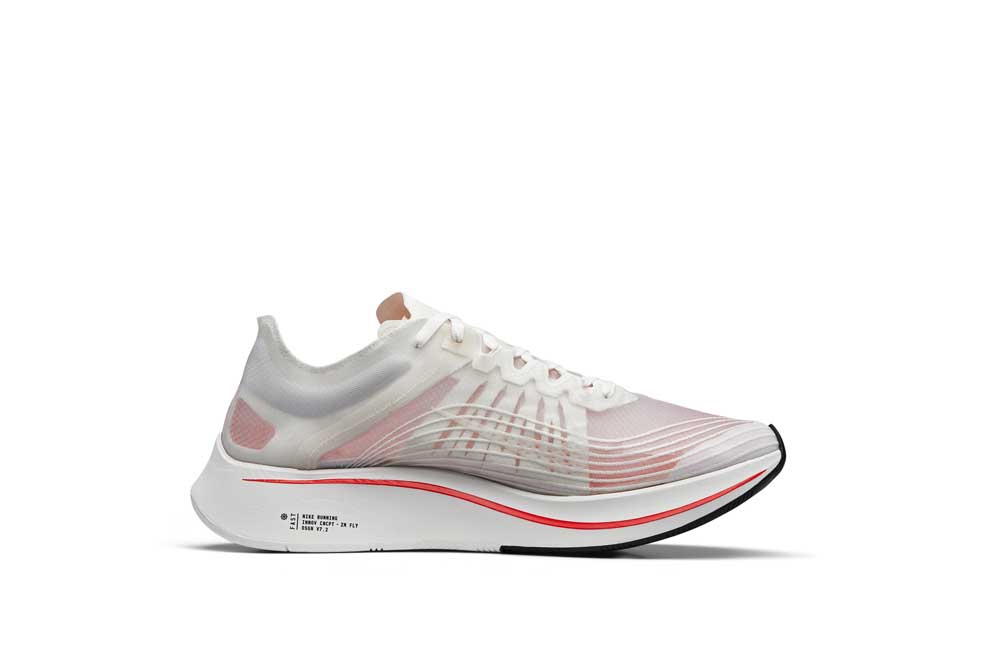Local runners participate in pioneering ‘maximal’ shoe study
Published 12:00 am Saturday, April 21, 2018

- The thick cushioning of “maximal” running shoes aims to decrease injury and improve form for runners.(Nike)
Running may seem like a no-frills alternative to elaborate, gear-heavy activities, such as cycling or, say, ski mountaineering.
Just strap on some shoes and go, right?
Trending
The sport’s simplicity gets complicated when your legs and feet begin hurting — the cumulative effect of pounding them along pavement and trail.
The abuse adds up.
Enter the surge of “maximal” shoes. Introduced by Hoka One One in 2010, the French company’s extra-cushioned running shoes were a stark rebuttal to the minimal running shoe trend — and its backlash. With millions of Hokas sold, other shoe manufacturers have begun releasing maximal offerings as well.
Dr. Christine Pollard, an Oregon State University-Cascades biomechanist and physical therapist found the maximal shoes curious. While much research had been dedicated to minimalist running shoes, Pollard’s new study on maximal shoes is the first to be conducted. Independent from any shoe manufacturer’s influence, Pollard enlisted more than 20 Central Oregon runners to participate in the study.
“In conventional running shoes, there is some cushioning in the forefoot. In most maximal shoes, midsole cushioning is nearly the same throughout the length of the shoe,” she said.
Pollard and Dr. JJ Hannigan, a post-doctoral researcher and runner, who co-investigated the research study at OSU-Cascades’ Functional Orthopedic Research Center of Excellence — or the FORCE lab — in the Therapeutic Associates physical clinic at The Center Orthopedic & Neurosurgical Care & Research.
Trending
The crux of the study: Does maximal shoes’ cushioning decrease the pressure with which their feet hit the ground? Or do runners mash their midsoles that much more because they can? And, with a proper transition from conventional running shoe to maximal shoes, can runners decrease the amount of strain on their legs?
“The big question is: What are these shoes doing?” Pollard said.
Pollard will present the findings of the study at her Science Pub talk, “The Biomechanics of Running Shoes — Is there an ‘ideal’ running shoe?” at Meadow Lakes Restaurant in Prineville on May 15. Her findings will also appear in the May issue of The Orthopaedic Journal of Sports Medicine.
From min to max
Running shoes originated in the late 19th century and resembled dress shoes for their stacked leather heels. They also featured spiked soles. The original modern running shoe is the New Balance Trackster, released in 1960, which featured a wavy tread pattern on the outsole, according to Runner’s World. Until the past decade, traditional running shoes’ midsoles featured 12 millimeters of midsole drop from the heel to the forefoot, Pollard said. This changed during the “barefoot” or minimal running craze that began in 2009. At the time, Pollard had recently finished her Ph.D. at the University of Massachusetts, where she conducted footwear testing for companies like New Balance and Brooks. The interest in minimal shoes was sparked by two factors: a study by Pollard’s mentor, Irene Davis, a doctor and director of the Spaulding National Running Center, and Christopher McDougall’s book “Born to Run,” which profiles a remote Mexican tribe that runs ultra distances while wearing sandals made from tires. These two factors made people wonder whether running shoes were over-engineered and enabled an exaggerated footfall called “heel striking” in the majority of runners. Shoes soon featured much thinner midsoles, which shoemakers said encouraged runners to land on the balls of their feet. One of the most extreme minimal shoes is the Vibram FiveFingers, glove-like footwear the company originally intended for water sports like rafting and kayaking. (Vibram settled a class-action lawsuit in 2014 for unsubstantiated claims of health benefits.)
“The thinking (during the minimal movement) was they would convert runners to forefront strikers, but that didn’t happen for the majority of individuals,” Pollard said.
During the height of the minimal craze, French company Hoka One One released its maximal shoe, which didn’t catch on until runners had felt duped or had injured themselves with minimal shoes.
Both converts and skeptics alike call maximal shoes marshmallows or clown shoes.
Runners are attracted to them for various reasons. Some are trying out the shoes, which retail between $100 and $150, as a last resort to mediate painful conditions, such as plantar fasciitis. Others are thinking about preventing injuries before they happen.
“I think generally the older someone gets the more attractive cushioning gets,” Hannigan said. “Generally people either love them or they hate them. Some people try them on, and they say they’re too heavy, they’re too clunky — it’s been very polarizing.”
While Pollard and Hannigan are mum on the study’s results, they did offer a peek at the findings. When subjects initially ran in maximal shoes, they proved to overcompensate for the cushioning, effectively pounding their feet harder because they could — like football players hitting harder as helmet and padding technology advances.
“We’re not sure if this only happens when they first try the shoes or if it’s going to keep happening after they’ve adjusted to them,” Hannigan said.
Mixed reviews
During a recent follow-up visit to the FORCE Lab, study participant and Bend ultrarunner Abbey Larkin, 29, strapped on a pair of Hoka One One Bondi 5s. The shoes are the most popular maximal shoe at FootZone. Larkin has put about 100 miles on the blue and purple Hokas, gradually running more mileage in the shoes each week. By the fifth and sixth weeks, participants were exclusively running in the maximal shoes, which only feature a 4 millimeter midsole offset from the heel to forefoot (a conventional off-set is 12 millimeters). After a warmup on the treadmill, Larkin stood while Hannigan and undergraduate OSU-Cascades kinesiology students attached a dozen reflective markers the size of peanut M&Ms on her pelvis, knees, ankles and toes. She then strode back and forth between eight infrared cameras, each time stepping on a force plate that measured impact. The collected data help Hannigan and Pollard study her form, particularly her “impact peak,” “loading rate” and “overall peak.” The higher a runner’s impact peak, for example, the greater odds of injury. The team also analyzed any change in a runner’s “pronation” or “supination” — which refers to how a runner’s foot laterally rocks when it connects with the ground. They juxtaposed the participants’ movements in the Hokas with what they observed when they ran in conventional running shoes that served as the study’s control.
Larkin began noticing maximal shoes on the feet of other runners at the ultramarathons she began racing three years ago. Initially she was skeptical.
“At first I was opposed to the idea of wearing (that much cushioning) because minimalism was the norm at that point,” Larkin said. “But seeing so many people who run a lot wear that kind of shoe made me change my mind. They told me they don’t have as many running-related injuries” said Larkin, who had run in conventional running shoes since she discovered track in junior high. “At ultramarathons, about 50 percent of people are wearing Hokas.”
After six weeks with them, Larkin wasn’t quite sold.
“Right above my knees and quads, I have this achy pain,” said Larkin, who is training for the 50K Tillamook Burn Trail Run later this month. “I noticed at first that my quads are really tight, and I haven’t had that problem before.”
When Larkin runs uphill, the extra thick midsoles push her onto her toes, helping her posture, which has previously begun crouched. Track intervals also give Larkin pause as she readjusts her footfall to prevent the thicker midsole from dragging in the last moment of her footfall. A couple of weeks after the study concluded, the symptoms went away, even though Larkin wears the Hokas while running on trails. During track workouts, she opts for a conventional running shoe.
“(The Hokas) make hills feel easier, she said with a laugh, adding that she thinks she’ll wear them during her 50K race. “But maybe that’s just in my mind.”
On a nearby computer screen, the reflective, different colored clusters darted by with the same bouncy cadence as Larkin’s. Hannigan stood nearby, watching Larkin’s gait stream on his computer screen. Brightly colored dot clusters represented Larkin’s extremities.
Fellow participant Hayden Anker hung out after his testing session. Unlike Larkin, Anker enjoys his miles in the Hokas as he trains for his first ultra-distance event, the 50-mile Siskiyou Out Back Trail Run in Ashland. Anker, 27 and from Bend, began considering new footwear when his go-to brand Pearl Izumi stopped making running shoes in late 2016. He was skeptical of the maximal shoes almost as much as the minimal shoe trend — which he called a “crock of junk” — yet he was pleased with the Hokas. Even though his six-week testing period is over, Anker intends to keep wearing the maximal shoes and anticipates buying a new pair once these wear out.
“I was like, ‘Dang, these things are comfortable.’ I liked them. They have a nice cushion,” Anker said, adding that he hasn’t developed any aches or pains in wearing them. He noticed that his strike pattern now centers on the balls of his feet instead of on his heels.
“That’s a response to the shoe,” Anker said.
Pollard, who is also an OSU-Cascades associate professor and the FORCE Lab director, co-founded the space through partnerships with The Center and its foundation, Therapeutic Associates and OSU-Cascades, said she hopes her study will further people’s understanding of what goes into an ideal running shoe — for them.
“Everyone wants to know what the right shoe for them is. The more we can understand biomechanically how these shoes operate and what they’re doing for runners, the more capable we are in making recommendations about what will benefit them most,” Pollard said. “Right now, it’s mostly anecdotal evidence — people stating their experiences. But we have biomechanical tools. We know what biomechanical variables are associated with injury, and we should be making recommendations based on science and evidence rather than on (anecdotes).”
— Reporter: 541-617-7816, pmadsen@bendbulletin.com








